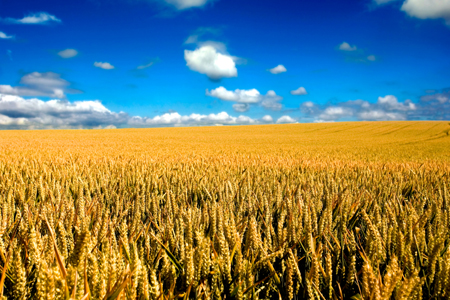Wheat Yields Break Trend, 10 Percent Over 5-Year Average
Category: Grains
 (Midwest Producer) – It is no secret that U.S. farmers produced a very large wheat crop this year. Looking past the bin-busting numbers, the longer term production trends and divergence from them this year are worth noting.
(Midwest Producer) – It is no secret that U.S. farmers produced a very large wheat crop this year. Looking past the bin-busting numbers, the longer term production trends and divergence from them this year are worth noting.
USDA’s Sept. 30 Small Grains Summary reported that, despite harvesting the smallest area in 46 years, U.S. farmers produced the largest wheat crop since 2008/09. USDA estimated that 2016/17 U.S. wheat production is up 258 million bushels (7.00 million metric tons [MMT]) to 2.31 billion bushels (62.9 MMT). That is a 13 percent increase from last year and 10 percent above the 5-year average of 2.09 billion bushels (57.0 MMT). A 21 percent improvement in average yield more than offset the smaller harvested area.
The low price market signals at planting time last fall encouraged farmers to plant less hard red winter (HRW), hard red spring (HRS) and soft red winter (SRW) wheat. Higher prices for soft white (SW) due to a drought-constrained supply encouraged Pacific Northwest (PNW) farmers to increase planted area slightly. Durum prices were also attractive at planting time, prompting an increase in planted area. However, the increases in SW and durum planted area were not enough to offset the decreases in the other classes. USDA reported U.S. farmers planted 50.1 million acres (20.3 million hectares) of wheat, down 8 percent year over year and 10 percent below the 5-year average.
A mild winter and early spring allowed winter wheat in the reduced planted area to emerge from dormancy in better than normal condition. The early spring also let farmers finish planting spring wheat well ahead of normal in most areas. Beneficial spring rains and favorable temperatures boosted average yields to a record 52.6 bu/acre (3.54 metric tons(MT) per hectare) for all U.S. wheat classes, up 21 percent from 2015/16 and 17 percent higher than the 5-year average of 44.9 bu/acre (3.02 MT/ha).
Over the past 50 years, U.S. wheat average yields increased by 4 bu/acre (0.27 MT/ha) each decade (about 0.20 percent each year) due to breeding improvements and more sophisticated farm management. It is safe to say that this year’s 9 bu/acre (0.60 MT/ha) increase in average yield significantly diverges from the trend line.
If yields had remained near the 5-year average, 2016/17 U.S. production would have been 53.9 MMT, 3 percent less than 2015/16. Therefore, the yield improvement benefits U.S. wheat buyers who can take advantage of decade-low prices to secure an abundant supply of high quality U.S. wheat this year.
With U.S. winter wheat planting well underway, farmers are now looking towards next year’s crop. How much winter wheat they will plant for 2017/18 is still unknown, but wheat prices hovering near decade lows and, for many farmers, below the cost of production would suggest that they will again plant less wheat. If yields return to the historic trend line, then production in the United States could be much smaller next year.
Here is a by-class breakdown of the Sept. 30 report.
Hard Red Winter (HRW). USDA reported 2016/17 HRW planted area at 26.5 million acres (10.7 million hectares), down 9 percent from 2015/16. With exceptionally favorable weather across much of the HRW growing region, USDA estimates total 2016/17 HRW production increased 30 percent to 1.08 billion bushels (29.4 MMT). Yields improved 54 percent and 50 percent from 2015/16 in Kansas and Oklahoma, the top two HRW-producing states.
Hard Red Spring (HRS). In the Northern Plains this year, HRS was not as competitive as pulses, durum and oilseeds, and planted area fell 9 percent from 2015/16 to 11.4 million acres (4.61 million hectares). Average yields in North Dakota, the top HRS-producing state, are projected to fall 4 percent from last year’s record high to 46.0 bu/acre (3.09 MT/ha). USDA projected HRS production at 493 million bushels (13.4 MMT), down 13 percent from the 2015/16 record.
Soft Red Winter (SRW). USDA estimated total 2016/17 SRW area at 6.58 million acres (2.66 million hectares), 7 percent lower than 2015/16 and 20 percent below the 5-year average. USDA expects SRW production will total 370 million bushels (10.1 MMT), up 3 percent from 2015/16, but 18 percent below the 5-year average of 451 million bushels.
Soft White (SW). Though fall planting in the PNW occurred during the third consecutive year of drought, wheat planted area increased slightly year over year to 4.15 million acres (1.68 million hectares). Then timely rains boosted yield potential across the PNW. USDA forecasts 2016/17 white production at 285 million bushels (7.78 MMT), a 27 percent increase year over year and 8 percent above the 5-year average of 257 million bushels (7.00 MMT).
Durum. Durum acreage increased again this year as farmers responded to higher prices. Northern durum is grown primarily in North Dakota and Montana, while Desert Durum is grown in Arizona and California. USDA estimates 2.14 million acres were planted to durum, up 24 percent from 2015/16 but still 5 percent below the 5-year average of 2.26 million acres. USDA estimated 2016/17 U.S. durum production at 104 million bushels (2.25 MMT), up 24 percent from 2015/16 after generally favorable weather boosted yields in the Northern Plains.
Stephanie Bryant-Erdmann is a market analyst for U.S. Wheat Associates.




